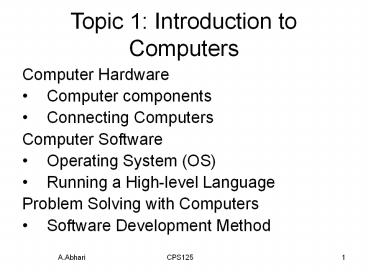Topic 1: Introduction to Computers - PowerPoint PPT Presentation
Title:
Topic 1: Introduction to Computers
Description:
Topic 1: Introduction to Computers Computer Hardware Computer components Connecting Computers Computer Software Operating System (OS) Running a High-level Language – PowerPoint PPT presentation
Number of Views:231
Avg rating:3.0/5.0
Title: Topic 1: Introduction to Computers
1
Topic 1 Introduction to Computers
- Computer Hardware
- Computer components
- Connecting Computers
- Computer Software
- Operating System (OS)
- Running a High-level Language
- Problem Solving with Computers
- Software Development Method
2
Computer components
- Central Processing Unit
- Memory
- Input/output devices
- Secondary storage
3
Computer Components
4
CPU
5
CPU
- Arithmetic/logic unit (ALU)
- Performs arithmetic operations (,-,...) and
logical operations (lt, gt, ...) - Control unit (CU)
- Decodes machine instructions and tells
- other components the required operations
- Registers
- store current instruction and values
6
Memory
- A collection of cells
- Each cell has an address and a value
- Random Access Memory (RAM)
- Cells can be accessed randomly
- Ram is volatile
- All data stored in binary format
- Bit, byte and word are the unit of data
7
CPU-Memory Interaction
Fetch-execute cycle
0 LDA 14
1 ADD 15
2 STA 14
3 HLT
.
14 10
15 7
Assume a is stored in 14 and b is stored in 15
Program
a a b
Result
14 17
15 7
8
Input/output Devices
- Text-based and GUI-based interaction
- Scanners, Touch screens
- Monitor, printer, speakers
Secondary Storage
- Floppy disk , CD (680 MB), DVD (4.717 GB),
- Tape, Hard disk
- File, Directory, Subdirectory, Folder
9
Hard Disk Drive Basics
10
Connecting Computers
- Local Area Network (LAN)
- Wide Area Network (WAN)
- Internet
- World Wide Web (WWW)
11
Computer SoftwareOperating System (OS)
- Part of OS is stored on Read Only Memory (ROM)
- OS is responsible for directing all computer
operations and resources - Command line interface (Unix)
- Graphical user interface (Windows)
12
Computer Software
- Application Software ( Word, Excel, etc.)
- Computer Languages
- Low level languages (machine language)
- High level language (C, Java, Fortran, )
13
Running a High-level Language
- Generating a source file (editor) gt tst.c
- Translating to machine code (compiler)
gttst.obj - Linking the object file with other object files
(linker) gttst.exe - Copying the executable file into memory (loader)
- Integrated Development environment (IDE) combines
all of these steps
14
Problem Solving with Computers (Software
Development Method)
- 1- Specify the problem requirement
- 2- Analyze the problem (input, output, additional
requirements). Modeling the problem (abstraction) - 3- Design the algorithm to solve the problem
- (top-down design or divide and conquer)
- 4- Implement the algorithmgt changing the
algorithm to a programming language
15
Problem Solving with Computers (Software
Development Method)
- 5- Test and verify the complete program, running
the program several times with different data
sets - 6- Maintain and update the program, removing
undetected errors - Failure is part of the process

